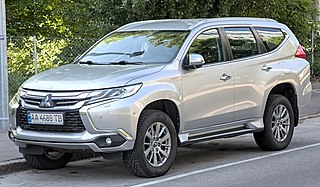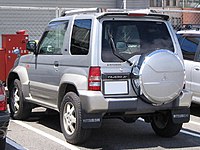
The Subaru Forester is a compact crossover SUV that has been manufactured by Subaru since 1997. The first generation was built on the platform of the Impreza in the style of a taller station wagon, a style that continued to the second generation, while the third-generation model onwards moved towards a crossover SUV design. A performance model was available for the second-generation Forester in Japan as the Forester STi.

The Mitsubishi Lancer Evolution, popularly referred to as the 'Evo', is a sports sedan and rally car based on the Lancer that was manufactured by Japanese manufacturer Mitsubishi Motors from 1992 until 2016. There have been ten official versions to date, and the designation of each model is most commonly a Roman numeral. All generations use two-litre intercooled turbo inline four-cylinder engines and all-wheel drive systems.

The Mitsubishi Eclipse is a sport compact car that was produced by Mitsubishi in four generations from 1989 until 2011. A convertible body style was added during the 1996 model year.

The Mitsubishi Galant is an automobile which was produced by Japanese manufacturer Mitsubishi from 1969 until 2012. The model name was derived from the French word galant, meaning "chivalrous". There have been nine distinct generations with total cumulative sales exceeding five million units. It began as a compact sedan, but over the course of its life evolved into a mid-size car. Initial production was based in Japan, but from 1994 the American market was served by vehicles assembled at the former Diamond-Star Motors (DSM) facility in Normal, Illinois.

The Mitsubishi Diamante is an automobile that was manufactured by Mitsubishi Motors from 1990 to 2005.

The Toyota Vitz is a subcompact car produced by the Japanese automobile manufacturer Toyota from 1999 to 2019 in a three- or five-door hatchback body styles. The "Vitz" nameplate was used consistently in Japan, while most international markets received the same vehicle as the Toyota Yaris, or as the Toyota Echo in some markets for the first generation. The Vitz was available in Japan from Toyota's Netz Store dealerships. Toyota began production in Japan and later assembled the vehicle in other Asian countries and in France.

The Mitsubishi Magna is a mid-size car that was produced over three generations between 1985 and 2005 by Mitsubishi Motors Australia Limited (MMAL). Developed as a replacement for the Mitsubishi Sigma, each Magna generation derived from Japanese platforms re-engineered for the Australian market and conditions. Initially, Magna offered inline-four engines in a mid-size sedan package—a station wagon debuted in 1987. Over the years, each new series grew in size, and with the second generation of 1991, the range was bolstered by a luxury variant called Mitsubishi Verada and a V6 engine. The Magna/Verada became the first Australian-made vehicle to be exported worldwide in large numbers, predominantly as the Mitsubishi Diamante. The third and final iteration Magna/Verada launched in 1996, adding all-wheel-drive (AWD) from 2002, and receiving a substantial styling update in 2003. They were replaced by the Mitsubishi 380 in 2005.

The Mitsubishi Pajero Mini is a kei car produced by Mitsubishi Motors from December 1994 until June 2012.

The Mitsubishi FTO is a front mid-engined, front-wheel drive coupe produced by Mitsubishi Motors between 1994 and 2000. Originally planned exclusively for the Japanese domestic market, its popularity as a grey market import to the United Kingdom, Ireland, Hong Kong, Singapore, Malaysia, Australia and New Zealand led to eventual limited distribution through Mitsubishi's official dealers in those regions at the tail-end of production. Upon its debut it won the Car of the Year Japan award for 1994–95, commemorated by a Limited Edition of the FTO GPX model.

The Mitsubishi Pajero Sport is a body-on-frame mid-size SUV produced by the Japanese manufacturer Mitsubishi Motors using the Pajero nameplate since 1996. Based on the Triton pickup truck, the Pajero Sport has spanned over three generations. It is unrelated to the full-size Pajero, which is built on a unibody chassis since 1999 and was discontinued in 2021.

The Mitsubishi Pajero is a full-size SUV manufactured and marketed globally by Mitsubishi over four generations — introduced in 1981 and discontinued in 2021.

The Mitsubishi i is a kei car from automaker Mitsubishi Motors, first released in January 2006, twenty eight months after its debut at the 2003 Frankfurt Motor Show. It is the first four-door automobile since the 1960s to employ a "rear midship" setup with the engine behind the passengers, in an attempt to improve safety and interior space without enlarging the overall exterior.

Tomica is a line of die-cast toy vehicles produced since 1970 by Takara Tomy Co. of Japan. Ostensibly, Tomica diecast were an outgrowth of Tomica World, an autonomous toy line of motorized train accessories that Tomy had created based on Plarail and produced since 1959. Similar in concept, Tomica can be thought of as the "Japanese Matchbox", but focuses mainly on Japanese brands.

The Mitsubishi Triton or Mitsubishi L200 is a mid-size pickup truck produced by Mitsubishi Motors. In Japan, where it has only been sold intermittently and in small numbers, it was originally known as the Mitsubishi Forte and from 1991 as the Strada. In the United States, Chrysler Corporation sold captive imports as the Dodge D50, Dodge Ram 50 and Plymouth Arrow truck, and Mitsubishi marketed it as the Mitsubishi Mighty Max until 2002.

The Mitsubishi Galant VR-4 was the range-topping version of Mitsubishi Motors' Galant model, available in the sixth (1987–93), seventh (1993–96) and eighth (1996–2002) generations of the vehicle. Originally introduced to comply with the new Group A regulations of the World Rally Championship, it was soon superseded as Mitsubishi's competition vehicle by the Lancer Evolution, and subsequently developed into a high-performance showcase of the company's technology.

The Mitsubishi Delica is a range of vans and pickup trucks designed and built by the Japanese automaker Mitsubishi Motors since 1968. It was originally based on a cabover van and pickup truck introduced the previous year, also called the Delica, its name a contraction of the English language phrase Delivery car. This pickup truck, and a commercial van derived from it has received many names in export markets, being sold as the L300 in Europe, Jamaica and New Zealand, Express and Starwagon in Australia, and plain Mitsubishi Van and Wagon in the United States. The passenger car versions were known as Delica Star Wagon from 1979 until the 1994 introduction of the Delica Space Gear, which became simply Space Gear in Europe at least. The most recent version is called the Delica D:5. With the exception of the first, versions of all generations are still being sold in various international markets.

The Mitsubishi Pajero iO is a mini SUV produced by the Japanese manufacturer Mitsubishi between 1999 and 2007. The "iO" name is derived from the Italian for "I" which, according to Mitsubishi, "generates an image of being easy to get to know, easy to drive, and of being one's very own Pajero".

The Mitsubishi RVR is a range of cars produced by Japanese manufacturer Mitsubishi Motors from 1991 to 2002 and then from 2010 until present. The first two generations were classified as compact multi-purpose vehicles (MPV), and the model introduced in 2010 is a subcompact crossover SUV.
All Wheel Control (AWC) is the brand name of a four-wheel drive (4WD) system developed by Mitsubishi Motors. The system was first incorporated in the 2001 Lancer Evolution VII. Subsequent developments have led to S-AWC (Super All Wheel Control), developed specifically for the new 2007 Lancer Evolution. The system is referred by the company as its unique 4-wheel drive technology umbrella, cultivated through its motor sports activities and long history in rallying spanning almost half a century.

The Toyota Corolla (E140/E150) is the tenth generation of cars marketed by Toyota under the Corolla nameplate. The Toyota Auris replaced the Corolla hatchback in Japan and Europe, but remained badged as a "Corolla" in Australia and New Zealand.






















